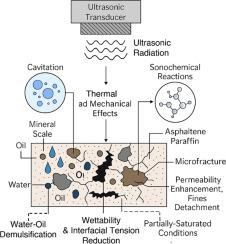Impact of ultrasonic waves on physicochemical characteristics of subsurface fluid-rock systems: A review on mechanisms, synergistic effects, and applications
IF 3.9
3区 工程技术
Q3 ENERGY & FUELS
Chemical Engineering and Processing - Process Intensification
Pub Date : 2025-07-25
DOI:10.1016/j.cep.2025.110471
引用次数: 0
Abstract
In recent decades, ultrasonic treatment has emerged as an environmentally friendly method for remediating groundwater contamination, enhancing the recovery of subsurface hydrocarbons, and improving the properties of fluid-rock interactions in subsurface systems. This review provides a comprehensive overview of the thermal, mechanical, and chemical mechanisms underlying ultrasonic wave propagation in porous media, with emphasis on its applications in groundwater remediation and enhanced hydrocarbon recovery. We explore ultrasound's capabilities in disintegrating organic and inorganic scales, reducing fluid viscosity, evolving emulsion systems, and improving permeability and wettability in subsurface environments. Particular attention is given to the synergistic effects achieved by combining ultrasound with other physical and chemical methods, such as chemical injection, thermal treatments, and nanofluid-enhanced recovery. Practical implications are discussed, including the stimulation of hydrocarbon-bearing formations, removal of formation damage, enhancement of sweep efficiency, and disruption of biofilms in groundwater systems, based on recent laboratory and field-scale studies. Despite its promise, field-scale implementation remains limited by challenges in modeling wave propagation and optimizing sonication parameters under variable formation conditions. Future research directions are proposed to advance scalable, sustainable ultrasound-based technologies in subsurface engineering.

超声波对地下流体-岩石系统物理化学特性的影响:机理、协同效应及应用综述
近几十年来,超声波处理已经成为一种环境友好的方法,用于修复地下水污染,提高地下碳氢化合物的采收率,改善地下系统中流体-岩石相互作用的性质。本文综述了超声波在多孔介质中传播的热、力学和化学机制,重点介绍了超声波在地下水修复和提高油气采收率方面的应用。我们探讨了超声波在分解有机和无机垢、降低流体粘度、形成乳液体系以及提高地下环境的渗透率和润湿性方面的能力。特别关注超声与其他物理和化学方法(如化学注射、热处理和纳米流体增强采收率)相结合所产生的协同效应。根据最近的实验室和现场规模研究,讨论了实际意义,包括增产含油气地层、消除地层损害、提高波及效率和破坏地下水系统中的生物膜。尽管前景看好,但在现场规模上的实施仍然受到各种挑战的限制,包括在可变地层条件下进行波传播建模和优化超声参数。提出了在地下工程中推进可扩展、可持续的超声技术的未来研究方向。
本文章由计算机程序翻译,如有差异,请以英文原文为准。
求助全文
约1分钟内获得全文
求助全文
来源期刊
CiteScore
7.80
自引率
9.30%
发文量
408
审稿时长
49 days
期刊介绍:
Chemical Engineering and Processing: Process Intensification is intended for practicing researchers in industry and academia, working in the field of Process Engineering and related to the subject of Process Intensification.Articles published in the Journal demonstrate how novel discoveries, developments and theories in the field of Process Engineering and in particular Process Intensification may be used for analysis and design of innovative equipment and processing methods with substantially improved sustainability, efficiency and environmental performance.

 求助内容:
求助内容: 应助结果提醒方式:
应助结果提醒方式:


